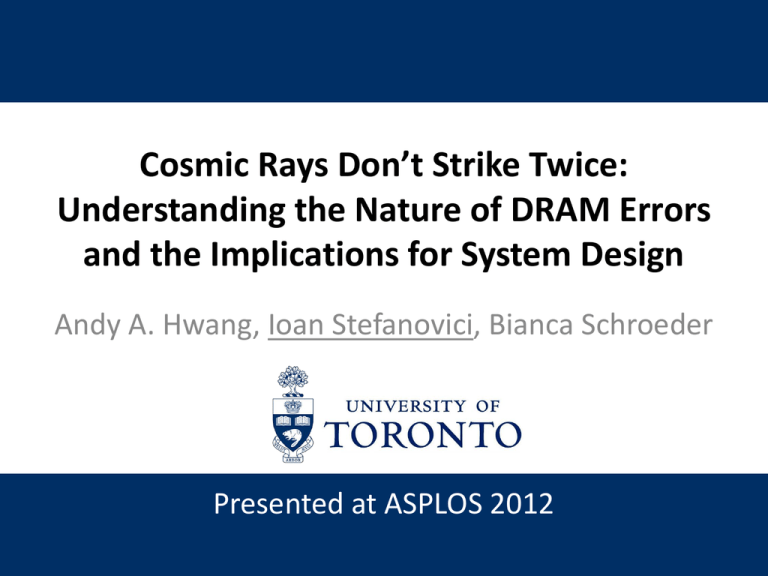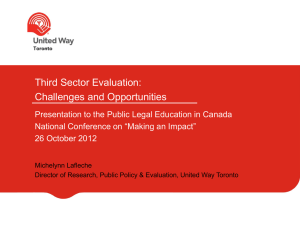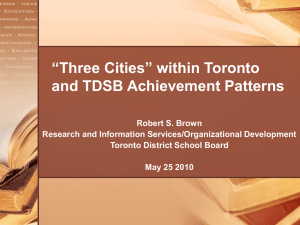Slides - University of Toronto
advertisement

Cosmic Rays Don’t Strike Twice: Understanding the Nature of DRAM Errors and the Implications for System Design Andy A. Hwang, Ioan Stefanovici, Bianca Schroeder Presented at ASPLOS 2012 Why DRAM errors? • Why DRAM? – One of the most frequently replaced components [DSN’06] – Getting worse in the future? • DRAM errors? – A bit is read differently from how it was written 1 0 University of Toronto 2 What do we know about DRAM errors? • Soft errors – Transient – Cosmic rays, alpha particles, random noise • Hard errors – Permanent hardware problem • Error protection – None machine crash / data loss – Error correcting codes • E.g.: SEC-DED, Multi-bit Correct, Chipkill – Redundancy • E.g.: Bit-sparing University of Toronto 3 What don’t we know about DRAM errors? • Some open questions – – – – – – What does the error process look like? (Poisson?) What is the frequency of hard vs. soft errors? What do errors look like on-chip? Can we predict errors? What is the impact on the OS? How effective are hardware and software level error protection mechanisms? • Can we do better? University of Toronto 4 Previous Work • Accelerated laboratory testing – Realistic? – Most previous work focused specifically on soft errors • Current field studies are limited – 12 machines with errors [ATC’10] – Kernel pages on desktop machines only [EuroSys’11] – Error-count-only information from a homogenous population [Sigmetrics’09] University of Toronto 5 DIMM DIMM CPU Memory Controller DIMM The data in our study • Error events detected upon [read] access and corrected by the memory controller • Data contains error location (node and address), error type (single/multi-bit), timestamp information. University of Toronto 6 The systems in our study System DRAM Technology Protection Mechanisms Time (days) DRAM (TB) LLNL BG/L DDR Multi-bit Correct, Bit Sparing 214 49 ANL BG/P DDR2 Multi-bit Correct, Chipkill, Bit Sparing 583 80 SciNet GPC DDR3 SEC-DED 211 62 Google DDR[1-2], FBDIMM Multi-bit Correct 155 220 • Wide range of workloads, DRAM technologies, protection mechanisms. • Memory controller physical address mappings • In total more than 300 TB-years of data! University of Toronto 7 How common are DRAM errors? Average # Median # Errors per Errors per Node / Year Node / Year System Total # of Errors in System Nodes With Errors LLNL BG/L 227 x 106 1,724 (5.32%) 3,879 19 ANL BG/P 1.96 x 109 1,455 (3.55%) 844,922 14 SciNet GPC 49.3 x 106 97 (2.51%) 263,268 464 Google 27.27 x 109 20,000 (N/A %) 880,179 303 • Errors happen at a significant rate • Highly variable number of errors per node University of Toronto 8 How are errors distributed in the systems? • Only 2-20% of nodes with errors experience a single error • Top 5% of nodes with errors experience > 1 million errors Top 10% of nodes with CEs make up ~90% of all errors After 2 errors, probability of future errors > 90% • Distribution of errors is highly skewed – Very different from a Poisson distribution • Could hard errors be the dominant failure mode? University of Toronto 9 What do errors look like on-chip? Error Mode Repeat address Repeat row Repeat column Whole chip BG/L Banks 80.9% 4.7% 8.8% row 0.53% Single Event 17.6% BG/P Banks 59.4% 31.8% 2 1 22.7% 3.20% 29.2% Google Banks 58.7% 7.4% 14.5% 2.02% 34.9% column University of Toronto 10 What do errors look like on-chip? Error Mode Repeat address Repeat row Repeat column Whole chip BG/L Banks 80.9% 4.7% 8.8% row 0.53% Single Event 17.6% BG/P Banks 59.4% 31.8% 1 22.7% 3.20% 29.2% Google Banks 58.7% 7.4% 2 14.5% 2.02% 34.9% column University of Toronto 11 What do errors look like on-chip? Error Mode Repeat address Repeat row Repeat column Whole chip BG/L Banks 80.9% 4.7% 8.8% row 0.53% BG/P Banks 59.4% 31.8% 1 22.7% 3.20% Google Banks 58.7% 7.4% 14.5% 2.02% 2 Single Event 17.6% 29.2% 34.9% column University of Toronto 12 What do errors look like on-chip? Error Mode Repeat address Repeat row Repeat column Whole chip BG/L Banks 80.9% 4.7% 8.8% row 0.53% BG/P Banks 59.4% 31.8% 1 22.7% 3.20% 5 4 Google Banks 58.7% 7.4% 14.5% 2 2.02% 3 Single Event 17.6% 29.2% 34.9% column University of Toronto 13 What do errors look like on-chip? Error Mode Repeat address Repeat row Repeat column Whole chip BG/L Banks 80.9% 4.7% 8.8% row 0.53% Single Event 17.6% BG/P Banks 59.4% 31.8% 1 22.7% 3.20% 29.2% Google Banks 58.7% 7.4% 14.5% 2.02% 34.9% column University of Toronto 14 What do errors look like on-chip? Error Mode Repeat address Repeat row Repeat column Whole chip BG/L Banks 80.9% 4.7% 8.8% 0.53% BG/P Banks 59.4% 31.8% 22.7% 3.20% Google Banks 58.7% 7.4% 14.5% 2.02% Single Event 17.6% 29.2% 34.9% • The patterns on the majority of banks can be linked to hard errors. University of Toronto 15 What is the time between repeat errors? 2 weeks • Repeat errors happen quickly – 90% of errors manifest themselves within less than 2 weeks University of Toronto 16 When are errors detected? • Error detection – Program [read] access – Hardware memory scrubber: Google only 1 day • Hardware scrubbers may not shorten the time until a repeat error is detected University of Toronto 17 How does memory degrade? • 1/3 – 1/2 of error addresses develop additional errors • Top 5-10% develop a large number of repeats • 3-4 orders of magnitude increase in probability once an error occurs, and even greater increase after repeat errors. • For both columns and rows University of Toronto 18 How do multi-bit errors impact the system? • In the absence of sufficiently powerful ECC, multi-bit errors can cause data corruption / machine crash. • Can we predict multi-bit errors? • > 100-fold increase in MBE probability after repeat errors • 50-90% of MBEs had prior warning University of Toronto 19 Are some areas of a bank more likely to fail? • Errors are not uniformly distributed • Some patterns are consistent across systems – Lower rows have higher error probabilities University of Toronto 20 Summary so far • Similar error behavior across ~300TB-years of DRAM from different types of systems • Strong correlations (in space and time) exist between errors • On-chip errors patterns confirm hard errors as dominating failure mode • Early errors are highly indicative warning signs for future problems • What does this all mean? University of Toronto 21 What do errors look like from the OS’ p.o.v.? • For typical 4Kb pages: • Errors are highly localized on a small number of pages – ~85% of errors in the system are localized on 10% of pages impacted with errors University of Toronto 22 Can we retire pages containing errors? • Page Retirement – Move page’s contents to different page and mark it as bad to prevent future use • Some page retirement mechanisms exist – Solaris – BadRAM patch for Linux – But rarely used in practice • No page retirement policy evaluation on realistic error traces University of Toronto 23 What sorts of policies should we use? Physical address space • Retirement policies: – – – – – Repeat-on-address 1-error-on-page 2-errors-on-page Repeat-on-row Repeat-on-column University of Toronto 2 1 24 What sorts of policies should we use? Physical address space • Retirement policies: – – – – – Repeat-on-address 1-error-on-page 2-errors-on-page Repeat-on-row Repeat-on-column University of Toronto 1 25 What sorts of policies should we use? Physical address space • Retirement policies: – – – – – Repeat-on-address 1-error-on-page 2-errors-on-page Repeat-on-row Repeat-on-column University of Toronto 1 2 26 What sorts of policies should we use? Physical address space • Retirement policies: – – – – – Repeat-on-address 1-error-on-page 2-errors-on-page Repeat-on-row Repeat-on-column On-chip 1 1 2 row 2 column University of Toronto 27 What sorts of policies should we use? Physical address space • Retirement policies: – – – – – Repeat-on-address 1-error-on-page 2-errors-on-page Repeat-on-row Repeat-on-column On-chip 1 1 row 2 column 2 University of Toronto 28 How effective is page retirement? • For typical 4Kb pages: (MBE) 1-error-on-page 1-error-on-pageRepeat-on-row Repeat-on-column Repeat-on-row 2-errors-on-page 2-errors-on-page Effective policy Repeat-on-address Repeat-on-address Repeat-on-column 1MB • More than 90% of errors can be prevented with < 1MB sacrificed per node – Similar for multi-bit errors University of Toronto 29 Implications for future system design • OS-level page retirement can be highly effective • Different areas on chip are more susceptible to errors than others – Selective error protection • Potential for error prediction based on early warning signs • Memory scrubbers may not be effective in practice – Using server idle time to run memory tests (eg: memtest86) • Realistic DRAM error process needs to be incorporated into future reliability research – Physical-level error traces have been made public on the Usenix Failure Repository University of Toronto 30 Thank you! Please read the paper for more results! Questions ? University of Toronto 31






